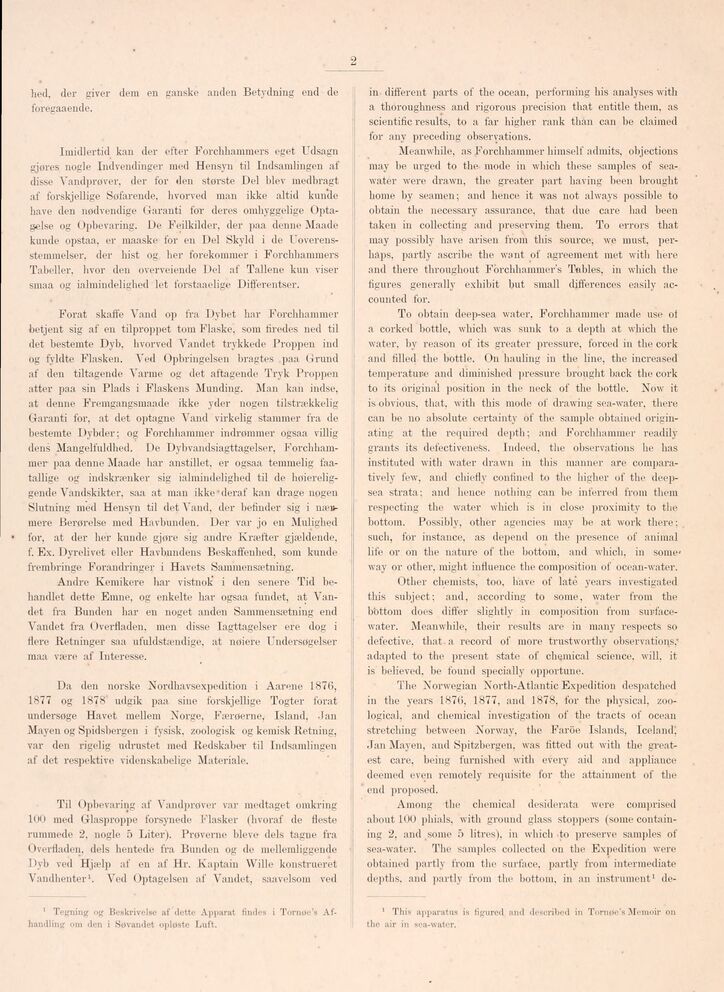
Full resolution (JPEG) - On this page / på denna sida - Sidor ...

<< prev. page << föreg. sida << >> nästa sida >> next page >>
Below is the raw OCR text
from the above scanned image.
Do you see an error? Proofread the page now!
Här nedan syns maskintolkade texten från faksimilbilden ovan.
Ser du något fel? Korrekturläs sidan nu!
This page has never been proofread. / Denna sida har aldrig korrekturlästs.
hed. der giver dem en ganske anden Betydning end de
foregaaende.
Imidlertid kan der efter Forchhammers eget Udsagn
gjøres nogle Indvendinger med Hensyn til Indsamlingen af
disse Vandprøver, der for den største Del blev medbragt
af forskjellige Søfarende, hvorved man ikke altid kunde
have den nødvendige Garanti for deres omhyggelige
Optagelse og Opbevaring. De Feilkilder, der paa denne Maade
kunde opstaa, er maaske for en Del Skyld i de
Uoverensstemmelser. der hist og her forekommer i Forchhammers
Tabeller, hvor den overveiende Del af Tallene kun viser
smaa og ialmindelighed let forstaaelige Differentser.
Forat skaffe Vand op fra Dybet har Forchhammer
betjent sig af en tilproppet tom Flaske, som firedes ned til
det bestemte Dyb. hvorved Vandet trykkede Proppen ind
og fyldte Flasken. Ved Opbringelsen bragtes .paa Grund
af den tiltagende Varme og det aftagende Tryk Proppen
atter paa sin Plads i Flaskens Munding. Man kan indse,
at denne Fremgangsmaade ikke yder nogen tilstrækkelig
Garanti for, at det optagne Vand virkelig stammer fra de
bestemte Dybder; og Forchhammer indrømmer ogsaa villig
dens Mangelfuldhed. De Dybvandsiagttagelser,
Forchhammer paa denne Maade har anstillet, er ogsaa temmelig
faatallige og indskrænker sig ialmindelighed til de
høiereliggende Vandskikter, saa at man ikke’deraf kan drage nogen
Slutning med Hensyn til det Vand, der betinder sig i
nærmere ßerørelse med Havbunden. Der var jo en Mulighed
for, at der her kunde gjøre sig andre Kræfter gjældende,
f. Ex. Dyrelivet eller Havbundens Beskaffenhed, som kunde
frembringe Forandringer i Havets Sammensætning.
Andre Kemikere har vistnok" i den senere Tid
behandlet dette Emne, og enkelte har ogsaa fundet, at
Vandet fra Bunden har en noget anden Sammensætning end
Vandet fra Overfladen, men disse Iagttagelser ere dog i
flere Retninger saa ufuldstændige, at nøiere Undersøgelser
maa være af Interesse.
Da den norske Nordhavsexpedition i Aarene 1876,
1877 og 1878’ udgik paa sine forskjellige Togter forat
undersøge Havet mellem Norge, Færøerne, Island, Jan
Mayen og Spidsbergen i fysisk, zoologisk og kemisk Retning,
var den rigelig udrustet med Redskabe-r til Indsamlingen
af det respektive videnskabelige Materiale.
Til Opbevaring af Vandprøver var medtaget omkring
100 med Glasproppe forsynede Flasker (hvoraf de fleste
rummede 2, nogle 5 Liter). Prøverne bleve dels tagne fra
Overfladen, dels hentede fra Bunden og de mellemliggende
Dyb ved Hjælp af en af Hr. Kaptain Wille konstrueret
Vandhenter1. Ved Optagelsen af Vandet, saavelsom ved
in different parts of the ocean, performing his analyses with
a thoroughness and rigorous precision that entitle them, as
scientific results, to a far higher rank than can be claimed
for any preceding observations.
Meanwhile, as Forchhammer himself admits, objections
may be urged to the mode in which these samples of
sea-water were drawn, the greater part having been brought
home by seamen; and hence it was not always possible to
obtain the necessary assurance, that due care had been
taken in collecting and preserving them. To errors that
may possibly have arisen from this source, we must,
perhaps, partly ascribe the want of agreement met with here
and there throughout Forchhammers Tables, in which the
figures generally exhibit but small differences easily
accounted for.
To obtain deep-sea water. Forchhammer made use ol
a corked bottle, which was sunk to a depth at which the
water, by reason of its greater pressure, forced in the cork
and filled the bottle. On hauling in the line, the increased
temperatur-e and diminished pressure brought back the cork
to its original position in the neck of the bottle. Now it
is obvious, that, with this mode of drawing sea-water, there
can be no absolute certainty of the sample obtained
originating at the required depth; and Forchhammer readily
grants its defectiveness. Indeed, the observations he has
instituted with water drawn in this manner are
comparatively few, and chiefly confined to the higher of the
deep-sea strata; and hence nothing can be inferred from them
respecting the water which is in close proximity to the
bottom. Possibly, other agencies may be at work there;
such, for instance, as depend on the presence of animal
life or on the nature of the bottom, and which, in some’
way or other, might influence the composition of ocean-water.
Other chemists, too. have of late years investigated
this subject; and, according to some, water from the
bbttom does differ slightly in composition from
surface-water. Meanwhile, their results are in many respects so
defective, that a record of more trustworthy observations,’
adapted to the present state of chemical science, will, it
is believed, be found specially opportune.
The Norwegian North-Atlantic Expedition despatched
in the years 1876, 1877, and 1878, for the physical,
zoological, and chemical investigation of the tracts of ocean
stretching between Norway, the Faroe Islands, Iceland;
Jan Mayen, and Spitzbergen, was fitted out witli the
greatest care, being furnished with every aid and appliance
deemed even remotely requisite for the attainment of the
end proposed.
Among the chemical desiderata were comprised
about 100 phials, with ground glass stoppers (some
containing 2. and some 5 litres), in which to preserve samples of
sea-water. The samples collected on the Expedition were
obtained partly from the surface, partly from intermediate
depths, and partly from the bottom, in an instrument1 de-
1 Tegning og Beskrivelse af dette Apparat findes i Tornøe’s
Afhandling om den i Søvandet opløste Luft.
1 This apparatus is figured and described in Tornøe’s Memoir on
the air in sea-water.
<< prev. page << föreg. sida << >> nästa sida >> next page >>